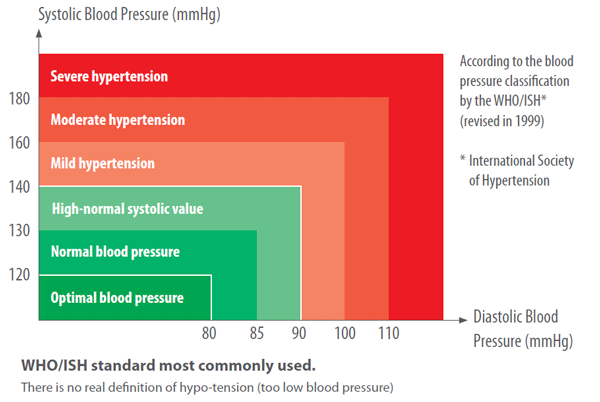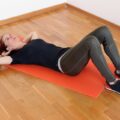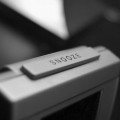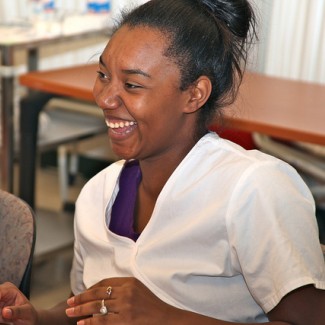With 1 of every 3 American adults suffering from high blood pressure, monitoring your blood pressure at home on a regular basis can keep your heart condition under control. As there are a few factors to consider and some important steps to follow, in this post we will provide you with essential and well-researched answers to:
- how to take blood pressure manually;
- how to take orthostatic blood pressure;
- what is the difference between systolic and diastolic arterial pressure?
- how long does it take to lower blood pressure?
- how often should you take your blood pressure?

Chart indicating measurements for low and optimal blood pressure to severe hypertension.
How to Take Blood Pressure Manually
In order to monitor your blood pressure at home correctly, please make sure you first:
- Check the accuracy of your blood pressure monitoring equipment. The easiest and the recommended way to do it is by taking your monitor to your doctor and checking it against his or her device. Taking your blood pressure with cuff and stethoscope (the instrument is called a sphygmomanometer) is not %100 accurate. Still, it gives results withing the 10% range.
- Avoid drinking coffee or alcohol, as well as smoking at least 30 minutes before taking a reading.
-
Go to the toilet before you wish to measure your blood pressure. Otherwise, the values may be altered.
- Find a quite place and relax. Your will need to hear your heartbeat so it is best not to speak along the process.
- Inform on how to properly take blood pressure, more specifically, on how to take a blood pressure reading. The chart featured above will give you an idea on what the optimal blood pressure is, as well as on hypotension and hypertension values.
- Learn how to take orthostatic blood pressure.
Next, if you want to learn how to take a blood pressure manually, without assistance, it is essential to follow a few simple instructions.
How to Take Manual Blood Pressure in 7 Easy Steps
- Roll up the sleeve (if you wear a long-sleeved shirt).
- Sit down on a chair and rest your arm on a table at your heart level. Use a pillow if needed.
- Place the Cuffs on your bare skin. Make sure they are tight.
- Position the stethoscope at the crease of the arm to locate your strongest pulse.
- Inflate and deflate the cuff (check the video below on how to take blood pressure manually).
- Listen for a first and second “thump” sound. The first occurrence of rhythmic sounds will indicate the systolic blood pressure, while the second, the diastolic blood pressure.
- Take a second reading. To check the accuracy of your blood pressure take a second reading on the other arm too. Wait a few minutes between readings.
How to Take Orthostatic Blood Pressure
Orthostatic hypotension is a medical term for the decrease in systolic and diastolic pressure withing three minutes of the pactient standing as compared with blood pressure taken while sitted. For taking orthistatic blood pressure using a cuff you will have to follow the steps ennuerated above, but also repeat the reading after standing 3 minutes. Don’t forget about the pulse rate measurements too.
It is also important to:
- Take your blood pressure twice a day – first in the morning, before breakfast but never right after you wake up – and then in the evening. Compare the measurements to see how your blood pressure fluctuates after a day of work.
- Always record you readings and inform your doctor on the values you get. From time to time pay his or her a visit and check your measurements against theirs.
Learn that there are various ways to check your blood pressure at home. Now that you have discovered the essential steps concerning how to take blood pressure with cuff correctly, let’s take a look at less popular or even unefficient ways to do it.
- How to take blood pressure with fingers
Unlike the popular belief that blood pressure can be determined by using your fingers, such measurement is totally inneffectual. On the other hand, you can use your fingers to check your pulse. Place your first and second fingertips on your arteries and as soon as you have felt your pulse begin counting the beats for 60 seconds.
- How to take blood pressure on leg
Until today, there is no blood pressure monitoring device for legs valided by the hypertension societies. However, you can take your blood pressure from the leg by using a cuff monitor, but note that it will be slightly different from the one in your arm. You can place the cuff either on your tigh, cald, or ankle. Studies suggest the ankle to be used in preference to the calf, but only if arm measurements are impossible or undesirable.
As we leave in a technological era, experts health care also recommend using an automatic monitor. You can alternate various monitoring devices and see which one works best for you.
How Often Should You Take Your Blood Pressure?
Scinetist from Harvard Medical School recommend you to take your blood pressure twice a day for a week. The first reading should take place early in the morning, before taking any medication, and the second, later in the evening. Then, keep on doing it twice a month, unless your doctor advice you differently.
Further Info
Looking for more information? The following instructional “how to take blood pressure” video might be of help.
There are also important and interesting facts about high blood pressure you may want to learn more about. Did you know that the in the morning arterial pressures indicate higher values as compared to evenings?
Learn more about how to take care of high blood pressure without medication in this MayoClinic article. Lowering your arterial pressure and level of daily stress is all about making lifestyle changes. How long does it take to lower blood pressure? Experts say that it all depends on your diet and exercise routine, as well as on additional conditions. Quitting drinking, for instance, might be a god start.
Do you ever take your blood pressure at home? Have you considered researching more on how to take blood pressure properly? Do let us know your results.
Image Source: Med-Health.net.












Leave a Reply